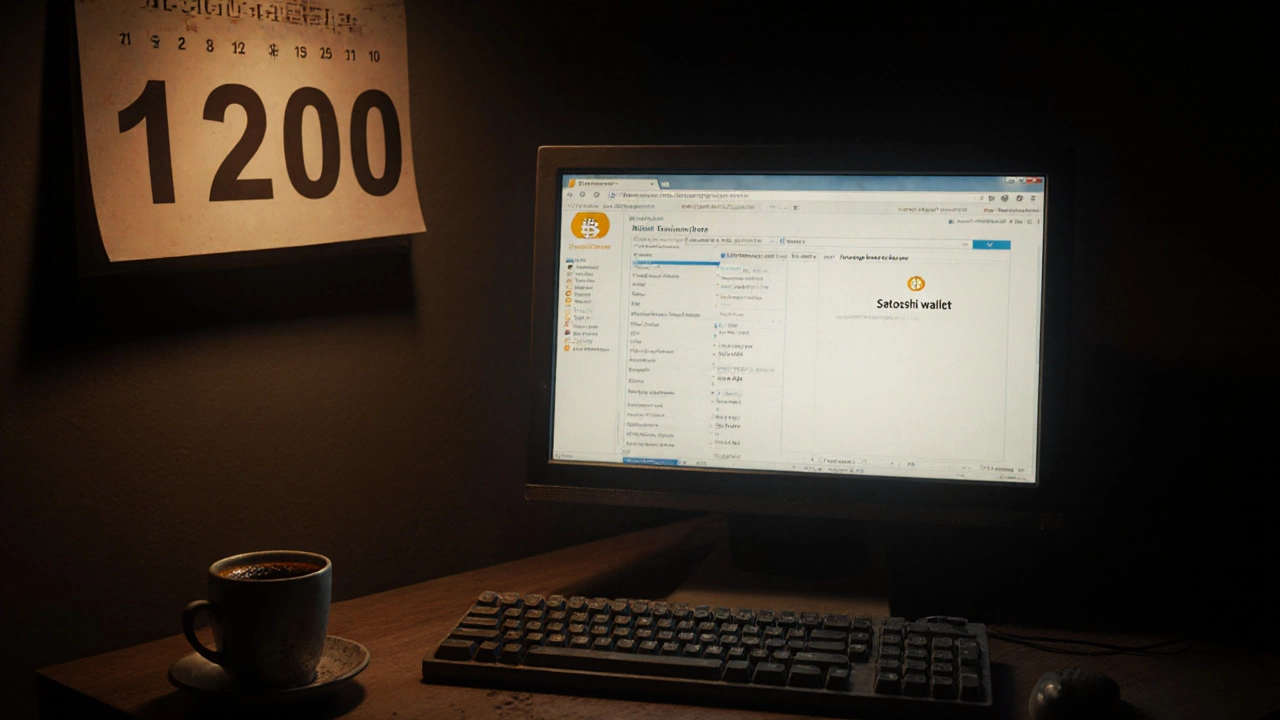Who Owns 90% of Bitcoin? The Real Holders Behind the Numbers
 Nov, 6 2025
Nov, 6 2025
Bitcoin Ownership Concentration Calculator
Use this tool to see how many top Bitcoin wallets would need to be combined to reach your selected percentage.
Ownership Concentration Analysis
Top wallets needed: 0
Enter a percentage above to see how many top Bitcoin wallets would need to be combined to reach that percentage of the total supply.
Key Insights from the Data:
• Top 10 wallets hold approximately 7% of all Bitcoin
• Top 100 wallets hold around 20%
• Top 1,000 wallets hold over 35%
• Top 10 exchange wallets combined hold about 9%
• The largest single wallet (genesis block) holds 5% of total supply
This concentration is due to early adoption, strategic accumulation, and institutional investment over time.
Bitcoin isn’t owned by a single person, a government, or even a tech giant. But if you look at the numbers, it’s clear that a tiny fraction of wallets control almost all of it. Around 90% of all Bitcoin is held by fewer than 1% of addresses. That’s not speculation-it’s on-chain data. And understanding who holds it changes how you think about Bitcoin’s power structure.
Who Are the Big Holders?
The biggest single holder isn’t a person-it’s a company. Bitcoin’s largest wallet belongs to Bitcoin is a decentralized digital currency that operates on a peer-to-peer network without a central authority. Also known as BTC, it was launched in 2009 by an anonymous developer or group using the pseudonym Satoshi Nakamoto. The first block, called the genesis block, contained 50 BTC that have never been moved. The wallet linked to the Bitcoin genesis block holds 1.1 million BTC, worth over $70 billion as of late 2025. That’s roughly 5% of the total supply. It’s been untouched since day one, meaning it’s not actively traded. This isn’t a person hoarding-it’s a locked-up relic of Bitcoin’s origin.
Then there are the exchanges. Coinbase, Binance, Kraken, and others hold hundreds of thousands of Bitcoin in hot and cold wallets. These aren’t their own money-they’re customer deposits. But because they control the private keys, they’re functionally the largest single holders of Bitcoin on paper. In fact, the top 10 exchange wallets combined hold over 1.8 million BTC, or about 9% of the total supply.
But the real concentration happens elsewhere. The top 1,000 Bitcoin wallets hold over 35% of all Bitcoin. The top 100? Over 20%. And the top 10? Around 7%. These aren’t random wallets. Many belong to early adopters, institutional investors, and crypto-native funds. Some are known: MicroStrategy holds over 200,000 BTC. Grayscale’s Bitcoin Trust holds over 650,000 BTC. Others are anonymous, but their patterns are clear. They’ve held through crashes, halvings, and regulatory crackdowns. These are the real long-term holders.
How Did This Happen?
Bitcoin’s supply is capped at 21 million. That’s fixed. But the distribution wasn’t equal from the start. In 2010, you could mine Bitcoin on a laptop. Early miners got massive amounts for almost nothing. One of the first Bitcoin transactions was for 10,000 BTC-bought for two pizzas. Today, that’s worth $600 million. The people who mined those early blocks didn’t sell. They kept them.
Then came the 2017 bull run. Bitcoin hit $20,000. New investors flooded in. But many sold at the top. The real wealth wasn’t made by those who bought at $10,000-it was made by those who bought at $100 and held. Those early adopters didn’t panic-sell. They bought more during dips. They didn’t care about headlines. They believed in the tech.
After 2021, institutional money poured in. Companies started adding Bitcoin to their balance sheets. ETFs launched. Pension funds and endowments got approval to invest. These aren’t retail traders. They’re institutions with legal teams, compliance officers, and long-term mandates. They don’t trade daily. They buy and hold. And they buy in bulk. That’s why the top wallets keep growing-even as retail investors come and go.

What About Satoshi Nakamoto?
Satoshi’s wallet holds about 1.1 million BTC. It’s been untouched since 2010. No one knows if Satoshi is alive. No one knows if they’re even one person. But that wallet is a ghost in the machine. If it ever moves, the market will react violently. Traders watch that wallet like a ticking bomb. It hasn’t moved in 15 years. That’s not luck. That’s discipline. Or maybe it’s just forgotten.
Some think Satoshi is dead. Others think they’re waiting for the right moment. Either way, that wallet is the single largest concentration of Bitcoin ever created. And it’s not going anywhere. It’s like a monument. A symbol. A warning: the original creator has more Bitcoin than any government, bank, or billionaire.
Why Does This Matter?
If 90% of Bitcoin is held by so few, does that make it centralized? Not technically. Bitcoin’s network is still decentralized. Anyone can run a node. Anyone can mine. Transactions are peer-to-peer. But the ownership is concentrated. That’s a different kind of power.
Imagine if Apple had 90% of its shares owned by one person. The company would still operate, but that person could influence every decision. Bitcoin doesn’t work that way. No single wallet can change the protocol. But they can move markets. If the top 10 holders all sold at once, Bitcoin’s price would crash. That’s not a threat to the network-it’s a threat to the people who bought in late.
This concentration creates a psychological effect. Retail investors see the big wallets and assume they know something. They follow them. They copy their moves. But most of those wallets don’t tweet. They don’t post on X. They don’t give interviews. They just hold. And that silence is louder than any influencer’s post.

Can This Change?
Yes. But it won’t be easy. Bitcoin’s design makes redistribution slow. You can’t print more. You can’t force people to sell. The only way ownership spreads is through time, price, and education.
As Bitcoin’s price rises, more people can afford to buy small amounts. Micro-investing apps let you buy $10 worth of Bitcoin. That’s how the next wave of holders will emerge. Not by buying 1 BTC, but by buying 0.0001 BTC every week. Over time, those small amounts add up. And they’re not in the top 1,000 wallets. They’re spread across millions of addresses.
There’s also the generational shift. Older holders are aging. Their heirs don’t always know how to access Bitcoin wallets. Some wallets are lost forever. Others will be inherited. When those wallets get passed down, they might get sold-or they might get held. Either way, ownership will shift. Slowly.
Regulation could force change. If governments require exchanges to report large holdings, more Bitcoin might move into private wallets. Or, if taxes on long-term holdings increase, some might sell. But none of these are guaranteed. Bitcoin’s rules are coded in stone. The only thing that can change ownership is time-and patience.
What Should You Do?
Don’t panic about who owns Bitcoin. Don’t assume the big holders are manipulating the market. They’re not. They’re just playing a longer game. If you’re buying Bitcoin to flip it in a month, you’re not in the same game. You’re playing a different sport.
Here’s what actually matters:
- Own your keys. If you don’t control your private keys, you don’t own Bitcoin. You own a promise from an exchange.
- Buy small and steady. Drip-feeding into Bitcoin over months or years reduces risk and builds real ownership.
- Ignore the noise. The top 10 wallets aren’t giving advice. They’re not posting memes. They’re not hyping. They’re just holding.
- Think long-term. Bitcoin’s value isn’t in who owns it today-it’s in what it becomes in 10, 20, 30 years.
Bitcoin isn’t about who has the most. It’s about who stays the longest. The 90% isn’t a threat. It’s a reflection of what happens when a system rewards patience. And that’s the real lesson.
Is it true that one person owns most of Bitcoin?
No single person owns most of Bitcoin. But a small number of wallets-mostly institutions, early adopters, and exchanges-hold about 90% of the total supply. The largest single wallet belongs to the genesis block, which has never been moved. No one knows who controls it, but it’s not actively traded.
Can the top Bitcoin holders crash the market?
Yes, if they sold all at once. But they don’t. Most of these holders are long-term investors or institutions with strict mandates. They buy and hold. They don’t trade daily. Even if they wanted to sell, moving millions of BTC would take months, giving the market time to adjust. A sudden dump is unlikely.
Do exchanges own Bitcoin?
Exchanges hold Bitcoin, but they don’t own it. The Bitcoin in exchange wallets belongs to their users. Exchanges just manage the private keys for convenience. If an exchange gets hacked or shuts down, users can lose access-unless they’ve withdrawn to their own wallets. That’s why self-custody matters.
Why hasn’t Bitcoin been distributed more evenly?
Early adopters got Bitcoin for free or cheap when it was worth pennies. They held through crashes. Newer buyers entered at much higher prices. The math doesn’t favor latecomers. But small, consistent purchases over time can help level the playing field. Bitcoin ownership is becoming more spread out, just very slowly.
What happens if Satoshi’s wallet is ever moved?
If Satoshi’s wallet moves, it would trigger massive market volatility. Traders would assume the creator is selling, which could cause panic. But it could also mean the creator is donating, moving to a more secure wallet, or even passing it on. No one knows what it means-only that it would be the most watched Bitcoin transaction in history.
